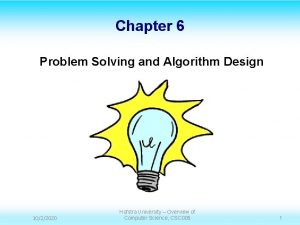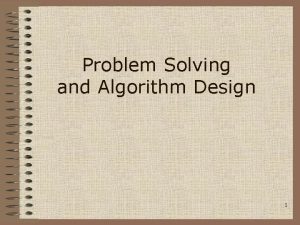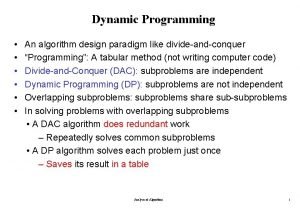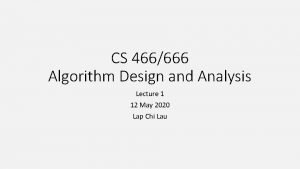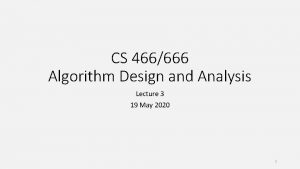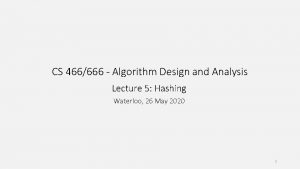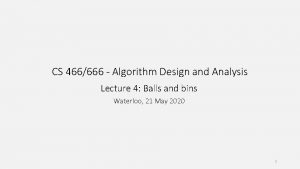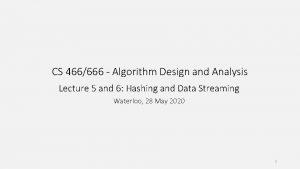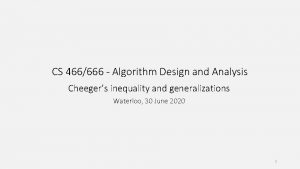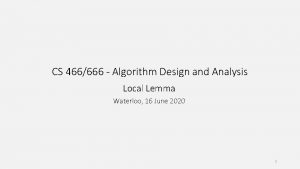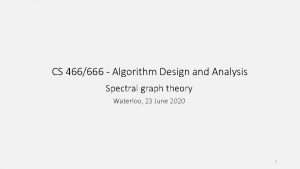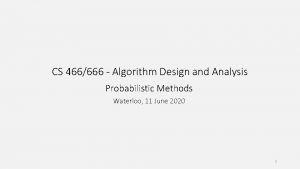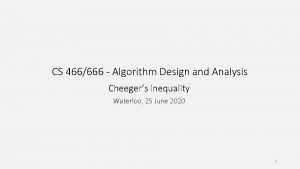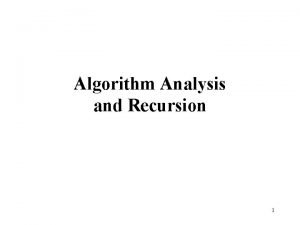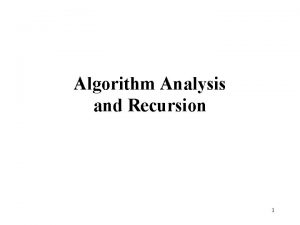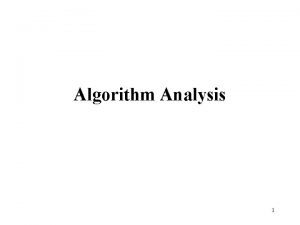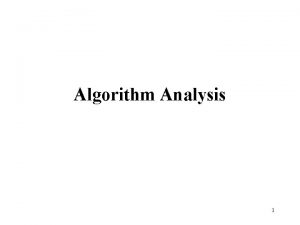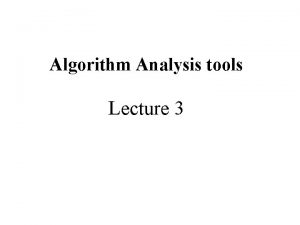CS 466666 Algorithm Design and Analysis Lecture 2































- Slides: 31

CS 466/666 Algorithm Design and Analysis Lecture 2 14 May 2020 1

Today’s Plan Finishing L 01 Quota increased Markov’s inequality HW 1 will be posted soon, due June 1 Chebyshev’s inequality Chernoff bounds 2

Karger’s algorithm Idea: just choose a random edge to contract! Karger’s Algorithm While there are more than two vertices in the graph choose a uniformly random edge uv and contract the two endpoints Output the edges between the remaining two vertices. Success probability in one execution >= 2/n(n-1) Repeat O(n^2) iterations => success probability >= 1 – exp(-20). Total time complexity = O(n^4). 3

Improving running time (sketch) 4

Improving running time (sketch) 5

Combinatorial structure How many minimum cuts can there be in an undirected graph? 6

Discussions Minimum k-cut Minimum s-t cut Minimum vertex cut Graph sparsification => near linear time algorithm 7

Homework Practice problems on probability Read chapter 1 and 2 of Mitzenmacher and Upfal. 8

Concentration inequalities How do we analyze randomized algorithms if their behavior are so random/unpredictable? Generally speaking, concentration inequalities are used to prove that a random variable is close to its expected value with high probability. These are very important tools in analyzing randomized algorithms, because they can be used to show that a randomized algorithms behaves almost deterministically, i. e. very close to what we “expect”. Hence, a very common strategy to analyze randomized algorithms is to look at the right random variables, then compute their expected values, and use concentration inequalities to prove that the outcomes are close to the expectation with high probability, and then 9

Bounding probability Suppose someone claims that they have an algorithm for sorting with expected running time 2 nlog(n). Suppose we have no further information about the algorithm. What bound can we give for the runtime of this algorithm to be more than 4 nlog(n)? If you know how to answer this question, then you already know Markov’s inequality. 10

Markov’s inequality 11

Questions 12

Moments and Variance 13

Covariance 14

Chebyshev’s inequality 15

Coin flips 16

Sum of independent random variables 17

First Approach 18

Approach using Markov’s inequality 19

Moment Generating Functions 20

Chernoff bound for heterogenous coin flips 21

Chernoff bound for upper tail 22

Chernoff bound for upper tail, a useful form 23

Chernoff bound for lower tail, a useful form Combining the upper tail and the lower tail, we obtain the following form which will be used frequently. 24

Hoeffding extension for bounded variables 25

Remarks 1. The same method applies for other (not necessarily bounded) random variables, e. g. Poisson, Gaussian, etc. We will see this in L 03. 2. Often, it is easier to compute the moments by computing the moment generating function. 3. Chernoff bounds also hold for negatively correlated random variables, e. g. edges in random spanning tree. 26

Coin flips 27

Probability Amplification, One-Sided Error If we have an algorithm that is always correct when it says YES, but is correct with 60% only when it says NO. How can we boost the success probability? 28

Probability Amplification, Two-Sided Error 29

Concentration inequalities Much more general phenomenon, not just for sums of independent random variables. Roughly speaking, holds for any function with bounded “influence” of each variable and bounded “dependency” between the random variables. It is a vast and beautiful mathematical topic. 30

Homework Read chapter 3 and 4 of Mitzenmacher and Upfal. 31
 01:640:244 lecture notes - lecture 15: plat, idah, farad
01:640:244 lecture notes - lecture 15: plat, idah, farad Anany levitin
Anany levitin Brute force polynomial evaluation algorithm
Brute force polynomial evaluation algorithm Form control in system analysis and design
Form control in system analysis and design Difference between a* and ao* algorithm
Difference between a* and ao* algorithm User interface design in system analysis and design
User interface design in system analysis and design Dialogue design
Dialogue design Define structured analysis
Define structured analysis Which of the following is not a fact finding technique
Which of the following is not a fact finding technique Feasibility
Feasibility Sweep line algorithm codeforces
Sweep line algorithm codeforces Eurocode 2 lap length table
Eurocode 2 lap length table Elemen urban design
Elemen urban design Interior design lecture notes+ppt
Interior design lecture notes+ppt Lecture hall background
Lecture hall background Game design lecture
Game design lecture Computer-aided drug design lecture notes
Computer-aided drug design lecture notes Cmos vlsi design lecture notes
Cmos vlsi design lecture notes Exploratory data analysis lecture notes
Exploratory data analysis lecture notes Sensitivity analysis lecture notes
Sensitivity analysis lecture notes Factor analysis lecture notes
Factor analysis lecture notes Analysis of algorithms lecture notes
Analysis of algorithms lecture notes Tiu lecture notes medical analysis
Tiu lecture notes medical analysis Zline 667-36
Zline 667-36 Algorithm design and problem solving
Algorithm design and problem solving Problem solving and algorithm design
Problem solving and algorithm design Kendall & kendall systems analysis and design
Kendall & kendall systems analysis and design Determining human information requirements
Determining human information requirements Kendall and kendall system analysis and design
Kendall and kendall system analysis and design System analysis and design kendall
System analysis and design kendall Systems analysis and design kendall
Systems analysis and design kendall Algorithm design paradigm
Algorithm design paradigm
























